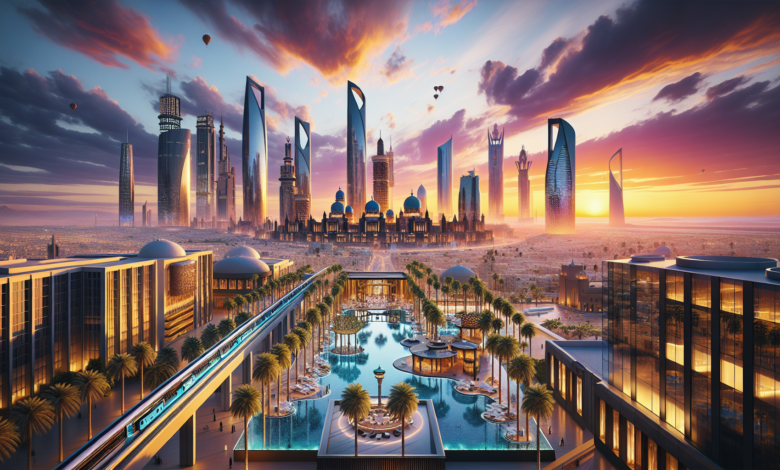
Saudi Arabia’s Tourism Triumph: Surpassing Vision 2030 Goals Early
Saudi Arabia has exceeded expectations in its tourism sector, surpassing the ambitious goals set by Vision 2030. A recent report from the International Monetary Fund (IMF) highlights the remarkable growth in Saudi Arabia’s tourism industry, showcasing its significant contribution to economic diversification. This achievement marks a pivotal moment for the Kingdom as it continues to transform its economy and attract international visitors.
The IMF report sheds light on several key factors driving Saudi Arabia’s tourism success. These include massive infrastructure improvements, the development of giga projects like NEOM, and a surge in international arrivals. The report also examines the impact of hosting major events such as Formula One races and the upcoming World Expo 2030. As Saudi Arabia makes strides in luxury tourism and cultural preservation, the tourism sector is becoming a crucial pillar of the country’s economic future, with its GDP contribution exceeding initial projections.
Saudi Arabia Surpasses Vision 2030 Tourism Goals
Saudi Arabia has exceeded its Vision 2030 tourism targets, welcoming over 106 million visitors in 2023, seven years ahead of schedule. This achievement has prompted the Kingdom to set a new goal of 150 million annual visitors by 2030. The tourism sector’s contribution to GDP reached 11.5% in 2023, with expectations to grow to 16% by 2034. Employment in the sector has surged, creating more than 2.5 million jobs, representing nearly one in five jobs in the country. International visitor spending increased by 57% to SAR 227.4 billion, while domestic visitor spending grew by 21.5% to SAR 142.5 billion. These figures underscore the sector’s pivotal role in Saudi Arabia’s economic diversification efforts and its success in becoming a global tourism hotspot.
IMF Report Highlights Economic Impact
The IMF’s 2024 Article IV Consultation report underscores Saudi Arabia’s tourism sector as a major contributor to economic diversification. Tourism revenues reached AED 132.20 billion in 2023, with net tourism income increasing by 38 percent. The sector’s direct and indirect contribution to GDP hit 11.5 percent in 2023, with projections to grow to 16 percent by 2034. Notably, Saudi Arabia’s service balance shifted to a surplus, indicating higher earnings from international visitors compared to outbound tourism spending. This transformation has created diverse linkages across industries, reducing reliance on oil-intensive sectors. The IMF report also highlights the role of strong domestic demand and rising international arrivals in driving non-religious tourism growth, further boosted by major events like Formula One and the upcoming World Expo 2030.
Key Drivers of Tourism Growth
Saudi Arabia’s tourism sector has experienced remarkable growth, driven by several key factors. The introduction of tourist visas in 2019 and the expansion of e-visas and visas on arrival have facilitated international travel to the Kingdom. Significant investments in tourist destinations like Al-Ula, Diriyah, and the Red Sea have enhanced the country’s appeal. The development of entertainment options, including sports events, cultural activities, and the “Saudi Seasons” program, has also contributed to the sector’s expansion. Religious tourism remains a substantial component, but non-religious tourism has surged, with 58% of arrivals in 2023 coming for non-religious purposes. Major events like Formula One races and the upcoming World Expo 2030 have further boosted the industry’s growth.
Vision 2030 and Future Projections
Saudi Arabia’s Vision 2030 has set ambitious targets for the tourism sector, which are being surpassed ahead of schedule. The country welcomed 100 million tourists in 2023, seven years earlier than planned, prompting a new goal of 150 million annual visitors by 2030. The sector’s contribution to GDP reached 11.5% in 2023, with projections to grow to 16% by 2034. Travel & Tourism is expected to continue its rapid growth, with GDP contribution forecast to reach SAR 498 billion in 2024 and SAR 836.1 billion by 2034. Employment in the sector is projected to increase, potentially reaching 3.6 million jobs by 2034, representing one in five jobs in the country.
Saudi Arabia’s remarkable achievements in the tourism sector have surpassed the ambitious goals set by Vision 2030, marking a turning point in the country’s economic diversification efforts. The IMF report underscores the sector’s significant contribution to GDP, job creation, and international visitor spending, highlighting its pivotal role in reshaping Saudi Arabia’s economic landscape. This success story showcases the Kingdom’s ability to transform itself into a global tourism hotspot, attracting millions of visitors for both religious and non-religious purposes.
Looking ahead, Saudi Arabia is poised to continue its upward trajectory in the tourism industry. With new targets set and ongoing investments in infrastructure, entertainment, and cultural preservation, the sector is expected to have an even greater impact on the country’s economy in the coming years. The Kingdom’s focus on hosting major events and developing world-class destinations puts it on track to become a leading player in the global tourism market, further solidifying its position as a diverse and dynamic economic powerhouse.
FAQs
- What are the main objectives of Saudi Arabia’s Vision 2030?
Vision 2030 in Saudi Arabia is structured around three core pillars: fostering a vibrant society, ensuring a thriving economy, and cultivating an ambitious nation. The focus is particularly on enhancing the quality of life for its citizens and deepening the roots of the Islamic faith. - How much investment is anticipated under Saudi Arabia’s Vision 2030?
Under Vision 2030, Saudi Arabia plans to inject over AED 11.71 trillion into its economy through various investment initiatives. This includes AED 4.77+ trillion from the Shareek program, AED 2934.03+ billion from the Public Investment Fund, and an additional AED 3.67+ trillion from investments facilitated by the National Investment Strategy. - What are the future projections for tourism revenue in Saudi Arabia?
By 2024, it is expected that the tourism sector in Saudi Arabia will generate revenues of approximately USAED 14512.26 million. This sector is anticipated to grow at an annual rate of 3.51%, reaching an estimated USAED 17244.32 million by 2029. - How has Vision 2030 influenced traffic safety in Saudi Arabia?
Vision 2030 has positively impacted traffic safety, evidenced by a significant reduction in traffic accidents. Specifically, there has been a decrease from 9953 to 7776 injuries and from 1920 to 1649 fatalities within a three-month period, following a second increase in fuel prices. This represents a decline of 21.9% in injuries and 14.1% in fatalities.





[…] and development. The Kingdom has built a strong technological foundation that supports its Vision 2030 goals. This shows Saudi Arabia’s clear path to becoming a global technology […]
[…] to revolutionize Saudi Arabia’s urban landscape while advancing the Kingdom’s Vision 2030 goals of economic diversification, sustainable development, and better quality of […]